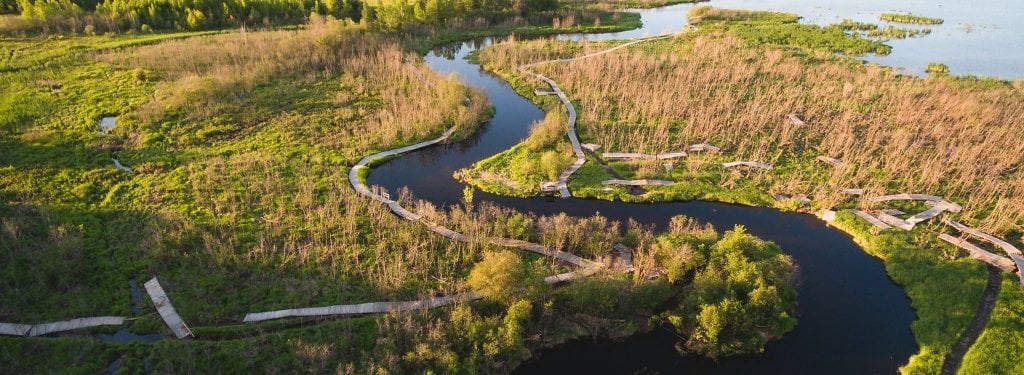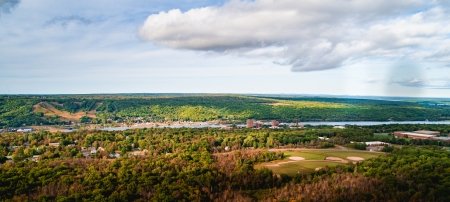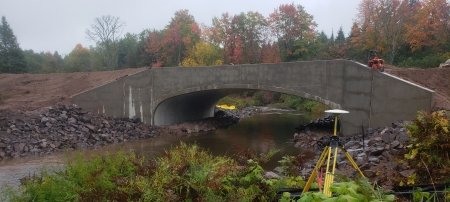Can We Bring the Grayling Back to Michigan?

Overfishing and destruction of its habitat have driven the Arctic grayling from its native Upper Michigan waters. But the Little River Band of Ottawa Indians is partnering with Michigan Technological University biologists Nancy Auer and Casey Huckins, looking into the possibility of bringing them back.
The fish, a member of the Salmonidae family of fish, like trout, disappeared long ago from Michigan’s rivers and lakes. Its range had stretched from the Au Sable River below the Mackinac Straits to the Otter River in the Keweenaw.
Auer, who is noted for her work with lake sturgeon, and Huckins, whose research focuses on coaster brook trout, are studying the viability of reintroducing Arctic grayling in the Big Manistee River watershed, where, Auer says, “In days of old, they used to be very abundant.”
The Little River Band of Ottawa Indians received a US Fish and Wildlife Service tribal wildlife grant to partially fund implementing a native species restoration plan. Auer and Huckins—both associate professors of biological sciences at Michigan Tech—have a two-year sub-award from the Tribe to study the potential for reintroducing the grayling.
Working with the biologists are two graduate students, Brian Danhoff, whom Huckins advises, and Cameron Goble, whose advisor is Auer. At the moment they are electro-fishing on the Manistee to record the resident fish, identifying potential competitors and predators. The faculty-student team is collaborating with Tribal staff and biologists Stephanie Ogren and Marty Holtgren. The Little River Band and Michigan Tech have collaborated before, including more than seven years of sturgeon restoration on the Big Manistee River.
Besides other species, the students are looking at river discharge, the substrate, water temperature and the availability of food “in the drift”—all to identify whether the characteristics of the aquatic environment could support grayling. “We want to have a really good idea about the suitability of the habitat before we move,” Auer explains. Overall, Huckins describes the objects of inquiry as the “biotic” (living things) and the “abiotic” (chemistry and physical makeup)—both aspects of the river system and its potential to support grayling.
The Manistee flows southwest for about 230 twisty miles, from near Alba to Manistee, where it empties into Lake Michigan.The watershed has more than 80 species of fish, including 13 non-natives, but no longer any grayling.
The Little River Band and Michigan Tech are focusing on a 11-mile section of the Big Manistee between two hydroelectric dams, Tippy and the Hodenpyl. What Huckins calls “the main stem” has six tributaries, which Auer calls “cold water inputs”—necessary because grayling require clean, cold water.
After the study is completed, the Little River Band and partners will determine future management actions for native species restoration within the Big Manistee watershed.
Meanwhile, Auer and Huckins are searching the scientific literature to determine ideal historic conditions and the best genetic strain of grayling to use, should reintroduction prove promising.
“It’s exciting to think that it might be possible,” Auer says. She is enamored of this native species. “Grayling are what we used to have, and they’re a remarkably pretty fish.”
There are two types of Arctic grayling, distinctive by an outsized dorsal fin: those that live in rivers and those that live in lakes. Auer and Huckins are looking at the river type for the Manistee. In North America, abundant populations of Arctic grayling thrive in Canada and Alaska. In the Lower Forty-eight, Montana has the sole self-sustaining grayling population, in the Big Hole River.
Why the big fin? “It’s always dangerous for us to say why a species has a distinctive feature,” Huckins says. “We don’t know why that feature evolved, why it’s so large and colorful.”
Huckins, who grew up in Montana, recalls seeing spawning grayling in a remote creek. “To this day, I remember those flapping dorsal fins waving back and forth,” he says. “It was almost magical.”
Should the inquiry lead to stocking, Auer and Huckins stress the importance of identifying the right strain of fish to stock to have the best chance for success. The State of Michigan tried restocking both river and lake grayling in the late 1980s and early 1990s, but the fish didn’t establish due to a number of factors, including hooking mortality, disease, predation and competition.
Auer notes that, in general, fish are highly adaptable, and non-natives, like salmon, black bass, and brown trout, “have been plunked all over the place for fishermen. We’ve played musical chairs with fish everywhere.” She adds. “Our lake trout are in Wyoming.”
Auer, Huckins, Holtgren and Ogren attended a symposium and workshop on Arctic grayling in Grand Prairie, Alberta, Canada, in June. “We were surrounded by people dedicated to the study and preservation of the species,” Huckins says. “We got great support. They said the potential is good. The logic is there.”
Auer adds, “The mantra from the professionals who work with grayling is persistence. You have to keep at it. If you want fish to come back, stick to a stream and work for several years. Don’t give up. “
Whether working with lake sturgeon, coaster brook trout or grayling, Auer says, “The goal is to get people aware of how beautiful these fish are, and how wonderful these ecosystems are. These big rivers are our lifeblood.”
The land around the target area on the Big Manistee is national forest and adjacent to the Tribe’s reservation—a protected place of abundant wildlife and beauty. Auer told a member of the Little River Band, “I just love coming down here. I love this forest.” The Tribal member replied, “Now you can see why our ancestors chose to live here.”
Huckins calls it “a gorgeous watershed with little land use beyond the natural”— which is good, Huckins adds, because grayling are a somewhat fragile species. “They are low on tenacity. They are more sensitive. They don’t tolerate land use well, and it appears they don’t tolerate strong competition,” the biologist explains.
He says the Manistee work is more than repopulating a fish. “It’s an important species to the tribe,” he says, “with spiritual and cultural connections.”
***
For more information on nonnative lake trout that were introduced into Wyoming in the 1890s, see: J.R. Ruzycki, D.A. Beauchamp, And D. L. Yule, Effects Of Introduced Lake Trout On Native Cutthroat Trout In Yellowstone Lake Ecological Applications, 13(1), 2003, pp. 23–37.
Michigan Technological University is an R1 public research university founded in 1885 in Houghton, and is home to nearly 7,500 students from more than 60 countries around the world. Consistently ranked among the best universities in the country for return on investment, Michigan's flagship technological university offers more than 185 undergraduate and graduate degree programs in science and technology, engineering, computing, forestry, business, health professions, humanities, mathematics, social sciences, and the arts. The rural campus is situated just miles from Lake Superior in Michigan's Upper Peninsula, offering year-round opportunities for outdoor adventure.




Comments